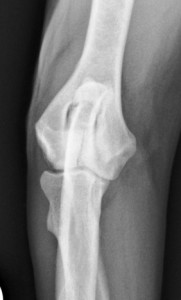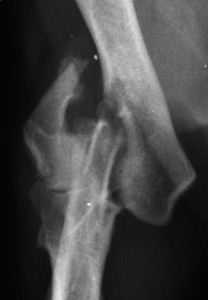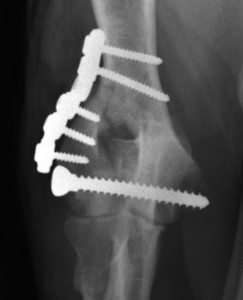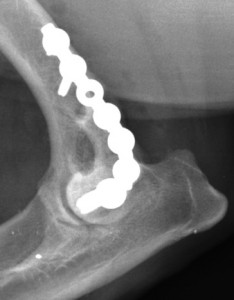Incomplete ossification of the humeral condyle (IOHC) is most frequently see in Spaniels.
This condition is often bilateral and predominantly affects Spaniels. It is the reason why Spaniels, especially Springer Spaniels in our experience, are massively overrepresented in the cases of humeral lateral, medial and Y/T condylar fractures that we see. The lateral and medial hemicondyles of the humerus are not united with bone across the isthmus of the condyle as they should be. This means only the lateral and medial epicondylar ridges support the lateral and medial hemicondyles, respectively.
Our experience is that these cases often present as juveniles; at around 4-5 years of age, or around 8-9 years of age. Should the patient jump down, the ulna semilunar notch can act like an axe and cleave off one or both hemicondyles. So these cases present with either intermittent forelimb lameness or after a fracture has occurred. Most patients that present before/without fracture have forelimb lameness and pain on elbow manipulation that is most noticeable on elbow extension.
Radiographical confirmation is difficult because the proximal ulna obscures the view of the isthmus. CT scanning is the gold standard for confirming the diagnosis. Arthroscopy can also be useful.
A transcondylar screw, typically 4.5mm or 5.5mm, can be placed across the condyle for prophylaxis to reduce the likelihood of fractures developing. This is relatively simple and cheap to do, and the exposure required is small. We typically leave the screw tip protruding a few threads “proud” from the bone. If the screw ever fails (through cyclical loading and metal fatigue), then this makes removal of the fragments much easier and the screw can often be replaced, typically with a larger diameter screw.
It has recently been reported by several surgeons working at several different hospitals that the incidence of infection after prophylactic screwing is significantly increased over comparable surgeries. While this hasn’t been our experience, we recognise the risk and we recommend prolonged prophylactic antibiosis for 2-3 weeks post-op.
The 4-year-old 29 kg Springer pictured below left, had had weight-bearing lameness for 5 weeks and was radiographed by the referring vet. IOHC was recognised but he fractured the lateral condyle in the few days before the owner could get down to us for a prophylactic screw placement, and so required fracture fixation with a locking plate.
3rd August 2014






